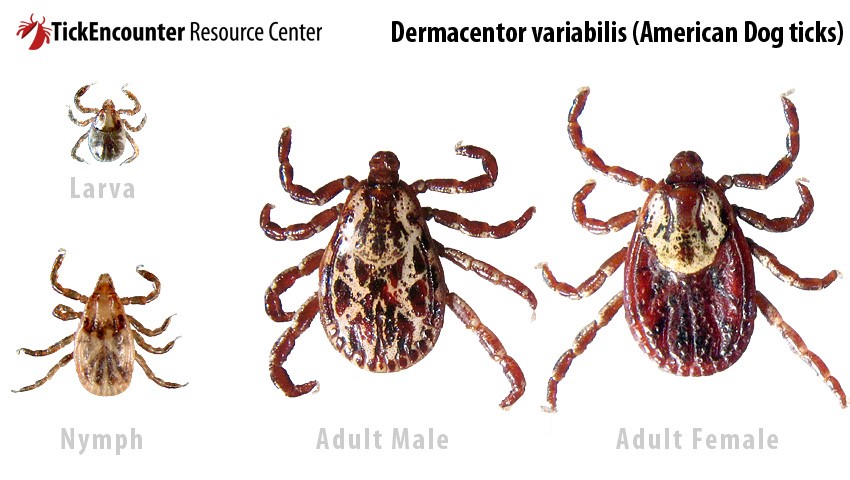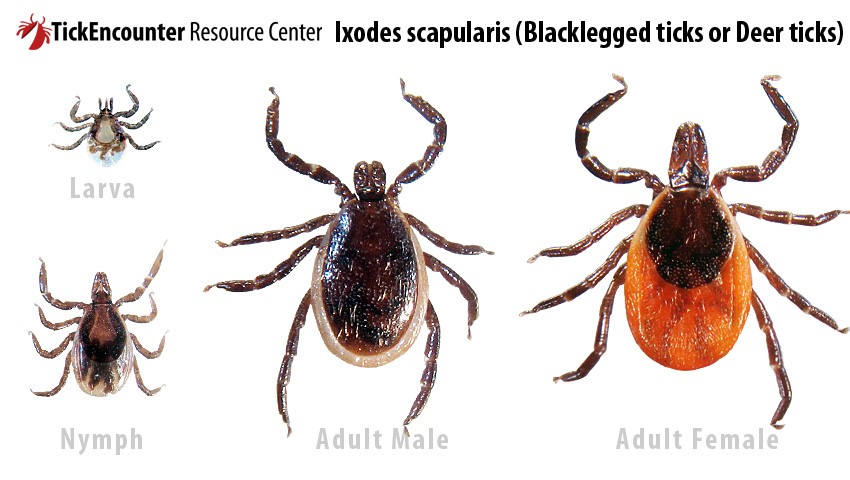Identifying Ticks
Recently, a tick species, the East Asian or Longhorned tick, that has never previously established a population in the US has been found in four states: New Jersey, Virginia, West Virginia and Arkansas. It has not been found in Kansas or anywhere in the Central Midwest. In its native range, these ticks are known to transmit theileriosis to cattle, and severe fever thrombocytopenia syndrome (SFTSV) in humans. Laboratory studies have evaluated the competency of this tick for various pathogens including Lyme spirochetes, spotted fever group rickettsiae, Ehrlichia chaffeensis and Anaplasma bovis; however, the results are mixed. At this time it is unknown if this tick transmits other animal or human diseases under field conditions in its native range. The other ticks listed on this page are commonly found in Kansas.
If you observe a tick that looks like the picture below, please contact the Kansas State Veterinary Diagnostic Laboratory Client Care at clientcare@vet.k-state.edu or 866-512-5650 for advice.
East Asian or Longhorned tick
(click pictures to enlarge images)
Click for more information ...
Distribution: The East Asian or longhorned tick is not known to be present in Kansas as of June 2018. This tick was first identified in North America in a New Jersey sheep farm in 2017, and they have been since confirmed to be present in Virginia, W. Virginia and Arkansas. Due to high volumes of livestock trade and transport across the country, this tick could turn up in any part of the country, including Kansas in the near-future. However, their ability to survive local conditions will highly vary. Identifying characteristics: The East Asian or longhorned ticks are similar in size and appearance to the other common ticks in Kansas. However, they lack some of the bodily colorations that are common to the ticks in this area. The adults and nymphs are reddish, reddish-brown in color and the larvae are small, pale yellow to red in color. Activity time: Likely during the normal tick season, April through August. Diseases they may transmit: The East Asian or longhorned ticks transmit theileriosis to cattle, and severe fever thrombocytopenia syndrome (SFTSV). These ticks are also potentially capable of transmitting other pathogens that cause Lyme disease, spotted fever, ehrlichiosis and anaplasmosis. Picture: © WRBCtv, 2018 |
Lone star tick

Click for more information ...
Distribution: Lone star ticks are the most common ticks found in the east, south eastern and central parts of Kansas. They are increasingly found west of Salina in the recent years, although in low numbers. Identifying characteristics: The adult ticks are readily visible, 4-5 mm long. The female ticks are easily identified with a prominent white mark on the back, and the males have prominent dark striations. The nymphs are small, 3-4 mm long, and are relatively pale red in color. The larvae are up to 2mm long, pale red in color and are hard to spot. Activity time: April through September. Ticks are found in areas frequented by wildlife and potentially some domestic animals, dense undergrowth and grassland. Diseases they may transmit: The lone star ticks carry different pathogens that are known to cause ehrlichiosis to dogs and humans, Southern Tick Associated Rash Illness (STARI), and tularemia. Picture: © TickEncounter Resource Center |
Spinose ear tick

Click for more information ...
Distribution: The spinose ear tick is found primarily in the arid and semiarid parts of the southwestern United States, but they can turn up in any part of the country due to livestock movement. Their ability to survive for longer periods in areas other than their native range is yet to be determined. However, these ticks are found worldwide, and are able to survive in many different climatic conditions. The spinose ear ticks are usually found around their hosts, which include cattle, horses, sheep, goats, and dogs. They are often found in high numbers on host animals. The adults are found off-host in dry, protected places, cracks and crevices under decaying wood and organic matter. Identifying characters: The spinose ear ticks are soft-bodied, and unlike the other commonly found tick species in the region they do not have a hard, dorsal shield or scutum. Their body shape is irregular, and the mouthparts are not visible when observed from the top. The nymphs are shaped somewhat like a violin with rear facing spines – therefore the name. Activity time: Throughout the year, depending on the location but peaking around the warm months. Diseases: The spinose ear ticks are not known to transmit any diseases to livestock and other animals. They parasitize their host animals particularly around the ears in large numbers causing ulceration, which may lead to secondary infections, loss of blood and hearing. Picture: © University of Georgia, USDA |
American dog tick

Click for more information ...
Distribution: American dog ticks are the second most common ticks found in all parts of Kansas. Identifying characteristics: The adult ticks are readily visible, 4-5 mm long. The female ticks are brown, and have a white to off-white coloring on the scutum, and the males have prominent white striations. The nymphs are small relative to adults, up to 4mm long, and are pale red in color. The larvae are 1-2 mm long, pale red to dark brown in color and are hard to spot. Activity time: April through September. Ticks are found in areas frequented by wildlife and potentially some domestic animals, edges of woodland, shrubs and also grassland. Diseases they may transmit: The American dog ticks are responsible for the transmission of anaplasmosis to cattle, Rocky Mountain spotted fever, and tularemia. Picture: © TickEncounter Resource Center |
Black legged tick

Click for more information ...
Distribution: The black legged ticks are increasingly found in the southeast and eastern parts of Kansas at relatively low numbers compared to the other tick species in the state. It is present in relatively high numbers in neighboring Missouri. Identifying characteristics: The adult ticks are easy to spot, and the females have a brown to reddish orange body with characteristic dark brown or black scutum on upper body and black legs. The males are black and are slightly smaller in size compared to females. Activity time: April through October with peak activities occurring during cooler weather. Diseases they may transmit: Lyme disease is transmitted by the black legged ticks. This is an emerging problem in eastern, southeastern Kansas. Picture: © TickEncounter Resource Center |
